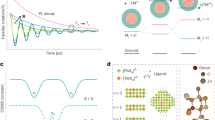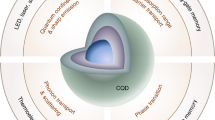Abstract
Strain can have a large influence on the properties of materials at the nanoscale. The effect of lattice strain on semiconductor devices has been widely studied, but its influence on colloidal semiconductor nanocrystals is still poorly understood. Here we show that the epitaxial deposition of a compressive shell (ZnS, ZnSe, ZnTe, CdS or CdSe) onto a soft nanocrystalline core (CdTe) to form a lattice-mismatched quantum dot can dramatically change the conduction and valence band energies of both the core and the shell. In particular, standard type-I quantum-dot behaviour is replaced by type-II behaviour, which is characterized by spatial separation of electrons and holes, extended excited-state lifetimes and giant spectral shifts. Moreover, the strain induced by the lattice mismatch can be used to tune the light emission—which displays narrow linewidths and high quantum yields—across the visible and near-infrared part of the spectrum (500–1,050 nm). Lattice-mismatched core–shell quantum dots are expected to have applications in solar energy conversion, multicolour biomedical imaging and super-resolution optical microscopy.
This is a preview of subscription content, access via your institution
Access options
Subscribe to this journal
Receive 12 print issues and online access
$259.00 per year
only $21.58 per issue
Buy this article
- Purchase on Springer Link
- Instant access to full article PDF
Prices may be subject to local taxes which are calculated during checkout





Similar content being viewed by others
References
Robinson, R. D. et al. Spontaneous superlattice formation in nanorods through partial cation exchange. Science 317, 355–358 (2007).
Lee, J. et al. Bandgap modulation of carbon nanotubes by encapsulated metallofullerenes. Nature 415, 1005–1008 (2002).
Suhr, J. et al. Fatigue resistance of aligned carbon nanotube arrays under cyclic compression. Nature Nanotechnol. 2, 417–421 (2007).
Hall, A. R., Falvo, M. R., Superfine, R. & Washburn, S. Electromechanical response of single-walled carbon nanotubes to torsional strain in a self-contained device. Nature Nanotechnol. 2, 413–416 (2007).
Roberts, M. M. et al. Elastically relaxed free-standing strained-silicon nanomembranes. Nature Mater. 5, 388–393 (2006).
Dabbousi, B. O. et al. (CdSe)ZnS core–shell quantum dots: Synthesis and characterization of a size series of highly luminescent nanocrystallites. J. Phys. Chem. B 101, 9463–9475 (1997).
Manna, L., Scher, E. C., Li, L. S. & Alivisatos, A. P. Epitaxial growth and photochemical annealing of graded CdS/ZnS shells on colloidal CdSe nanorods. J. Am. Chem. Soc. 124, 7136–7145 (2002).
McBride, J., Treadway, J., Feldman, L. C., Pennycook, S. J. & Rosenthal, S. J. Structural basis for near unity quantum yield core/shell nanostructures. Nano Lett. 6, 1496–1501 (2006).
Chen, X. B., Lou, Y. B., Samia, A. C. & Burda, C. Coherency strain effects on the optical response of core/shell heteronanostructures. Nano Lett. 3, 799–803 (2003).
Maki, H., Testuya, S. & Ishibashi, K. Direct observation of the deformation and the band gap change from an individual single-walled carbon nanotube under uniaxial strrain. Nano Lett. 7, 890–895 (2007).
Li, Y. H., Gong, X. G. & Wei, S. H. Ab initio all-electron calculation of absolute volume deformation potentials of IV–IV, III–V and II–VI semiconductors: the chemical trends. Phys. Rev. B 73, 245206 (2006).
Li, J. B. & Wang, L. W. Deformation potentials of CdSe quantum dots. Appl. Phys. Lett. 85, 2929–2931 (2004).
Brunner, K. Si/Ge nanostructures. Rep. Prog. Phys. 65, 27–72 (2002).
Lamberti, C. The use of synchrotron radiation techniques in the characterization of strained semiconductor heterostructures and thin films. Surf. Sci. Rep. 53, 1–197 (2004).
Mueller, A. H. et al. Multicolor light-emitting diodes based on semiconductor nanocrystals encapsulated in GaN charge injection layers. Nano Lett. 5, 1039–1044 (2005).
Tan, Z. N. et al. Bright and color-saturated emission from blue light-emitting diodes based on solution-processed colloidal nanocrystal quantum dots. Nano Lett. 7, 3803–3807 (2007).
Hell, S. W. Far-field optical nanoscopy. Nature Biotechnol. 316, 1153–1158 (2003).
Persson, J., Hakanson, U., Johansson, M. K. J., Samuelson, L. & Pistol, M. E. Strain effects on individual quantum dots: Dependence of cap layer thickness. Phys. Rev. B 72, 085302 (2005).
Wei, S. H. & Zunger, A. Predicted band-gap pressure coefficients of all diamond and zinc-blende semiconductors: Chemical trends. Phys. Rev. B 60, 5404–5411 (1999).
Peng, X. G., Schlamp, M. C., Kadavanich, A. V. & Alivisatos, A. P. Epitaxial growth of highly luminescent CdSe/CdS core/shell nanocrystals with photostability and electronic accessibility. J. Am. Chem. Soc. 119, 7019–7029 (1997).
Kim, S., Fisher, B., Eisler, H. J. & Bawendi, M. Type-II quantum dots: CdTe/CdSe(core/shell) and CdSe/ZnTe(core/shell) heterostructures. J. Am. Chem. Soc. 125, 11466–11467 (2003).
Piryatinski, A., Ivanov, S. A., Tretiak, S. & Klimov, V. I. Effect of quantum and dielectric confinement on the exciton–exciton interaction energy in type II core/shell semiconductor nanocrystals. Nano Lett. 7, 108–115 (2007).
Xie, R., Zhong, X. & Basche, T. Synthesis, characterization and spectroscopy of type-II core/shell semiconductor nanocrystals with ZnTe cores. Adv. Mater. 17, 2741–2745 (2005).
Chen, C. Y. et al. Spectroscopy and femtosecond dynamics of type-II CdSe/ZnTe core–shell semiconductor synthesized via the CdO precursor. J. Phys. Chem. B 108, 10687–10691 (2004).
Jeong, S. et al. Effect of the thiol–thiolate equilibrium on the photophysical properties of aqueous CdSe/ZnS nanocrystal quantum dots. J. Am. Chem. Soc. 127, 10126–10127 (2005).
Adachi, S. Properties of Group-IV, III–V and II–VI Semiconductors (John Wiley & Sons, 2005).
Bawendi, M. G., Kortan, A. R., Steigerwald, M. L. & Brus, L. E. X-ray structural characterization of larger CdSe semiconductor clusters. J. Chem. Phys. 91, 7282–7290 (1989).
Murray, C. B., Norris, D. J. & Bawendi, M. G. Synthesis and characterization of nearly monodisperse CdE (E = S, Se, Te) semiconductor nanocrystallites. J. Am. Chem. Soc. 115, 8706–8715 (1993).
Yeh, C. Y., Lu, Z. W., Froyen, S. & Zunger, A. Zinc-blende–wurtzite polytypism in semiconductors. Phys. Rev. B 46, 10086–10097 (1992).
Wei, S. H. & Zhang, S. B. Structure stability and carrier localization in CdX (X = S, Se, Te) semiconductors. Phys. Rev. B 62, 6944–6947 (2000).
Talapin, D. V. et al. Highly emissive colloidal CdSe/CdS heterostructures of mixed dimensionality. Nano Lett. 3, 1677–1681 (2003).
Manna, L., Wang, L. W., Cingolani, R. & Alivisatos, A. P. First-principles modeling of unpassivated and surfactant-passivated bulk facets of wurtzite CdSe: A model system for studying the anisotropic growth of CdSe nanocrystals. J. Phys. Chem. B 109, 6183–6192 (2005).
Goldstein, A. N., Echer, C. M. & Alivisatos, A. P. Melting in semiconductor nanocrystals. Science 256, 1425–1427 (1992).
Zhang, J. Z., Zhao, Y. S. & Palosz, B. Comparative studies of compressibility between nanocrystalline and bulk nickel. Appl. Phys. Lett. 90, 043112 (2007).
Tolbert, S. H. & Alivisatos, A. P. High-pressure structural transformations in semiconductor nanocrystals. Annu. Rev. Phys. Chem. 46, 595–625 (1995).
Zhang, X. Y., Sharma, P. & Johnson, H. T. Quantum confinement induced strain in quantum dots. Phys. Rev. B 75, 155319 (2007).
Meulenberg, R. W., Jennings, T. & Strouse, G. F. Compressive and tensile stress in colloidal CdSe semiconductor quantum dots. Phys. Rev. B 70, 235311 (2004).
Oron, D., Kazes, M. & Banin, U. Multiexcitons in type-II colloidal semiconductor quantum dots. Phys. Rev. B 75, 035330 (2007).
Huynh, W. U., Dittmer, J. J. & Alivisatos, A. P. Hybrid nanorod–polymer solar cells. Science 295, 2425–2427 (2002).
Smith, A. M., Duan, H., Mohs, A. M. & Nie, S. M. Bioconjugated quantum dots for in vivo molecular and cellular imaging. Adv. Drug Deliv. Rev. 60, 1226–1240 (2008).
Yu, W. W., Wang, Y. A. & Peng, X. G. Formation and stability of size-, shape- and structure-controlled CdTe nanocrystals: Ligand effects on monomers and nanocrystals. Chem. Mater. 15, 4300–4308 (2003).
Li, J. J. et al. Large-scale synthesis of nearly monodisperse CdSe/CdS core/shell nanocrystals using air-stable reagents via successive ion layer adsorption and reaction. J. Am. Chem. Soc. 125, 12567–12575 (2003).
Jasieniak, J. J. & Mulvaney, P. From Cd-rich to Se-rich—the manipulation of CdSe nanocrystal surface stoichiometry. J. Am. Chem. Soc. 129, 2841–2848 (2007).
Proffen, Th. & Neder, R. B. DISCUS: a program for diffuse scattering and defect-structure simulation. J. Appl. Cryst. 30, 171–175 (1997).
Acknowledgements
The authors would like to thank Hong Yi, Zhong L. Wang, Yong Ding and A. Kumbhar for assistance with transmission electron microscopy, K. Hardcastle for help with powder X-ray diffraction, and R. Dickson, T. Lian, A. Issac and P. Nicovich for help in fluorescence lifetime data measurements. This work was supported by the NIH Roadmap Initiative in Nanomedicine through a Nanomedicine Development Centre award (PN2EY018244), and was also supported in part by NIH grants (P20 GM072069, R01 CA108468, U01HL080711 and U54CA119338), and by the DOE Genomes to Life (GTL) Program. A.M.S. acknowledges the Whitaker Foundation for generous fellowship support and S.M.N is a Distinguished Scholar of the Georgia Cancer Coalition (GCC).
Author information
Authors and Affiliations
Contributions
A.M.S. and S.M.N. conceived and designed the experiments. A.M.S. performed the experiments. A.M.S. and S.M.N. analysed the data. A.M.M. contributed materials/analysis tools. A.M.S. and S.M.N. co-wrote the paper.
Corresponding author
Supplementary information
Supplementary Information
Supplementary Information (PDF 2404 kb)
Rights and permissions
About this article
Cite this article
Smith, A., Mohs, A. & Nie, S. Tuning the optical and electronic properties of colloidal nanocrystals by lattice strain. Nature Nanotech 4, 56–63 (2009). https://doi.org/10.1038/nnano.2008.360
Received:
Accepted:
Published:
Issue Date:
DOI: https://doi.org/10.1038/nnano.2008.360
This article is cited by
-
Exploring the probing capacities of MSA capped CdTe semiconductor quantum dots as optical chemsensors via analytical and isotherms modeling for selective Hg2+ detection
Applied Water Science (2024)
-
Synthesis and Modulation of Low-Dimensional Transition Metal Chalcogenide Materials via Atomic Substitution
Nano-Micro Letters (2024)
-
InP colloidal quantum dots for visible and near-infrared photonics
Nature Reviews Materials (2023)
-
Enhanced supercapacitor performance of Mg-doped SnO2 nanorods synthesized through the solvothermal method
Bulletin of Materials Science (2023)
-
A roadmap for the commercialization of perovskite light emitters
Nature Reviews Materials (2022)



